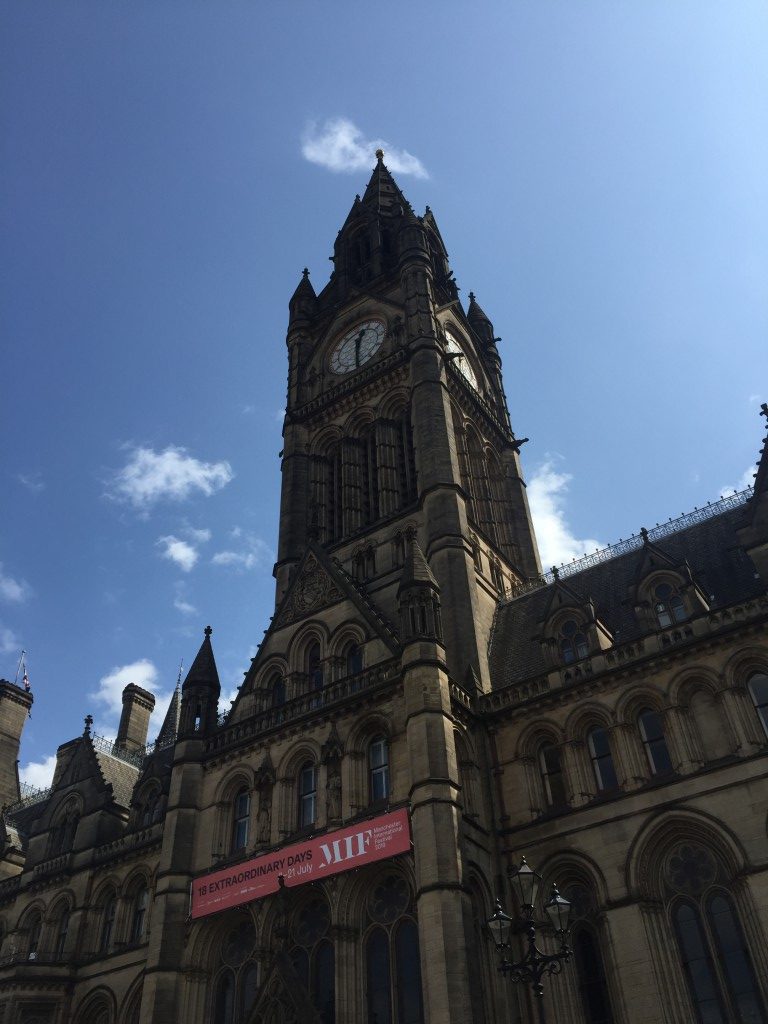The story of Frank Sidebottom.
A Mancunian legend with a papier – mache head. But what is the story of Frank Sidebottom? Here we take a look at Frank’s creator Chris Sievey.
The days before Frank Sidebottom
Chris grew up in Sale which is a suburb to the south of Manchester. He was originally a musician although not a very successful one. He had partnerships with various musicians in the 70’s and 80’s. He started a band called The Freshies. They had some local success with a song with a fantastic name. I’m in love with the girl on the Manchester Virgin Megastore checkout desk. The record got to number 54 in the charts.
The creation of Frank Sidebottom
Frank Sidebottom was created in 1984. Frank was a 35 year old aspiring pop star who still lived with his mum. He lived in the south Manchester village of Timperley. Frank always dressed in a sharp suit but was most recognisable for his huge head. This was originally made from papier – mache and later fibreglass.
During the late 80’s and 90’s Franks popularity in Manchester grew. He would regularly appear on the comedy circuit and even had his own TV show. Frank Sidebottom’s fantastic shed show was first broadcast in 1992. He was a cult figure and would appear on late night music shows along top artists. Sometimes they didn’t know what to make of him.
One Manchester’s most unique statues.
Sadly Chris died in 2010 and with him took the story of Frank Sidebottom. In 2013 a statue of Frank Sidebottom was unveiled right in the heart of Timperley village. As you can see it is a pretty unique statue. Frank was afterall a pretty unique character.
You can visit Timperley and have a photo with the statue by taking the metrolink south. While you’re there make sure to pop into the Quarry Man pub. They do a great ploughman’s lunch.
Join our mailing list and keep up with all things Manchester. If you’d like to explore more of Manchester join our food tour. www.manchesterbites.com for more details.
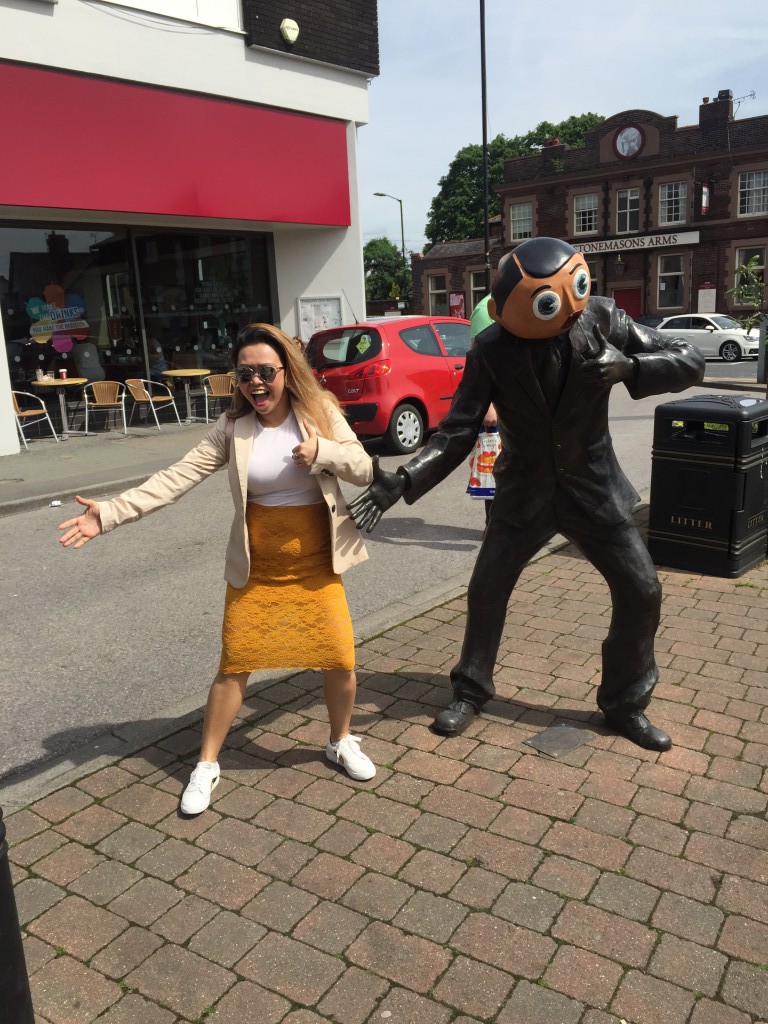
Manchester’s Free Trade Hall. And that Dylan concert.
We are lucky to have numerous historical buildings in Manchester city centre. One such building that you can visit is Manchester’s Free Trade Hall. Built in 1856 this grade 2 listed building stands on the site of the Peterloo Massacre. Originally the building was used as a meeting place for the local business community.
It had a vital role in the repealing of the corn laws. The corn laws meant that imports of grain, corn and wheat were taxed. This meant that landowners in Britain could charge a higher price for their corn. As a result it became more expensive to eat. Over time many urban centres such as Manchester rose up and rebelled against the law. The Free Trade Hall was Manchester’s epicentre for anti corn law demonstrations.
Fast forward to December 1940. Manchester was under attack from the German Luftwaffe. The Free Trade Hall suffered great damage. Only the frame of the building survived. In the 1950’s the hall was re-built behind the original outer wall.
A centre of Manchester’s music scene.
The Free Trade Hall became home to Manchester’s Halle Orchestra. In fact it continued to be their home right up until 1996. That is when the Bridgewater Hall took over. It wasn’t just classical concerts that the hall held. One of the most famous episodes in the hall’s history came in 1966.
Bob Dylan was touring the UK and at the time was causing quite some controversy. Dylan was using an electric guitar which was seen by many of his fans as distasteful. At a gig in the Free Trade Hall on 16th May, Dylan was heckled and called “Judas” by a concert goer. Many fans started to slow clap and some even walked out. Dylan kept going. He knew what he was doing was changing the face of music at the time. In 1998 Dylan released the recording of the gig. Manchester bands such as The Fall, The Smiths and Joy Division all say they were heavily influenced by this event.
Today the Free Trade Hall is a Radisson Hotel. You can still go in and admire the stunning entrance hall and enjoy a drink at the bar.
If you are interested to know more about Manchester and it’s incredible history, book a tour with us. Our food tours take in some of Manchester’s best local bites as well as a wealth of history and culture. To book a tour go to www.manchesterbites.com
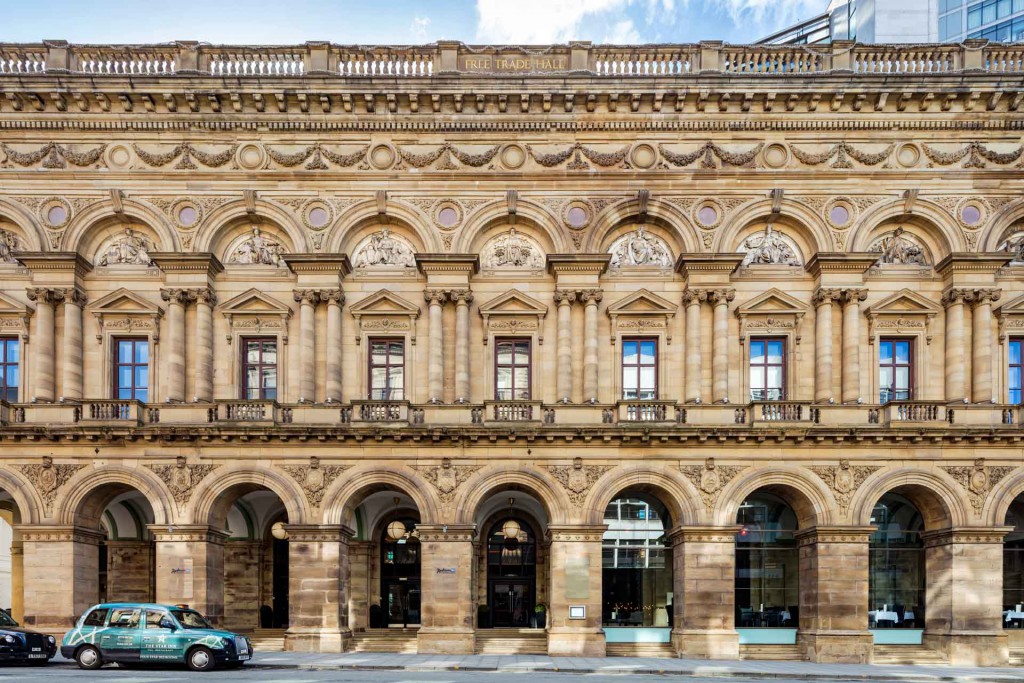
The Peveril of the Peak. A Manchester institution.
The Pev has been a Manchester institution for decades. It is known to many for its unusual 2 tone green facade. The tiles on the outside walls of the pub have led some people to describe it as an old toilet. But to those who know it, the Pev is one of the last proper drinking pubs in Manchester.
The pub dates back to the early 19th century. The name is said to have come from a stagecoach which used to travel between London and Manchester. The coach would stop off at the pub en route.
The Pev’s claims to fame.
It is the one of the only pubs in Manchester city centre that is detached, meaning you can walk all around it. This is due to the modernisation of the surrounding land. Where once there would be rows of terraced housing there are now shiny office blocks and towers. Now the Pev is almost on an island itself. In between Chepstow street and Bridgewater street.
The Pev also has the honour of having the longest serving landlady in Manchester. In January 2021 Nancy and Maurice will have been living above the pub for 50 years. They now have a much more hands off approach. The bar is now run by a younger team who have done well in keeping the spirit of the place in tact.
Like many of Manchester’s older pubs, the Peveril of the Peak has seen a few famous faces. It was used in the filming of Robbie Coltrane’s crime thriller, Cracker. It’s laid back, local atmosphere means that whoever you are you’ll get a welcome. Nowadays the Bridgewater hall is located a stone’s throw away.
Our historical pub tour of Manchester is a great way to spend an early evening. If you’d like to learn more about Manchester and it’s pubs go to www.manchesterbites.com

Vimto: A Manchester Innovation
Manchester has a long history when it comes to inventing things. The computer, graphite, commercial railways, indie music, football…the list goes on and on. One of our food and drink gifts to the world has been Vimto.
If you’ve never tried it, Vimto is a fruit-flavoured soft drink with true cult status. It contains grapes, berries and blackcurrants (and also, admittedly, lots of sugar).
In the UK we have a similar drink called Ribena. If you speak to anyone from Manchester you’ll realise that we are If Ribena is the UK’s most iconic berry flavoured drink, Vimto is the stylish person’s alternative choice.
Preferred in Manchester to just about any other soft drink, Vimto’s reputation across the rest of the UK tends to be defined by people who haven’t tried Vimto, and people who love Vimto and champion it at every opportunity!
A History of Vimto
At the start of the 20th century, a man called John Nichols used to sell herbs, spices and medicines in Manchester. He developed the recipe for what he called Vim Tonic. It was originally a medicinal drink but came to be regarded as a soft drink in 1913 and with that, the name was shortened to Vimto.
Due to the popular temperance movement of the period, which encouraged people to lead teetotal lifestyles, soft drinks were all the rage. And Vimto successfully made a name for itself within this culture.
It wasn’t, though, until the 1990s that Vimto really established itself as the trendy person’s booze-free tipple of choice. British culture in the 90s was defined by a slightly unruly, anti-establishment attitude. With Brit Pop acts like Blur, Pulp, and Oasis (yes, another Manchester export!) at the top of the charts, and anarchical TV shows like TFI Friday and The Word being watched by millions, anything too middle-of-the-road was, well, a bit naff.
Well, the marketing guys at Vimto had their finger on the pulse because the brand enlisted the perfect representative to advertise their brand: the slightly rude cartoon poet, Purple Ronnie. Created by writer and illustrator Giles Andreae, Purple Ronnie became a rogueish, much-loved figure on British TV, famous for his love of partying and innuendo-laden poems. One of his rhymes went as follows:
Vimto is a smashing drink
So why not have a slurp?
It’s full of fizzy bubbles
To make your bottom burp
In 2003, Purple Ronnie walked off into the sunset and Vimto adopted the new slogan “Shlurpling the Purple”.
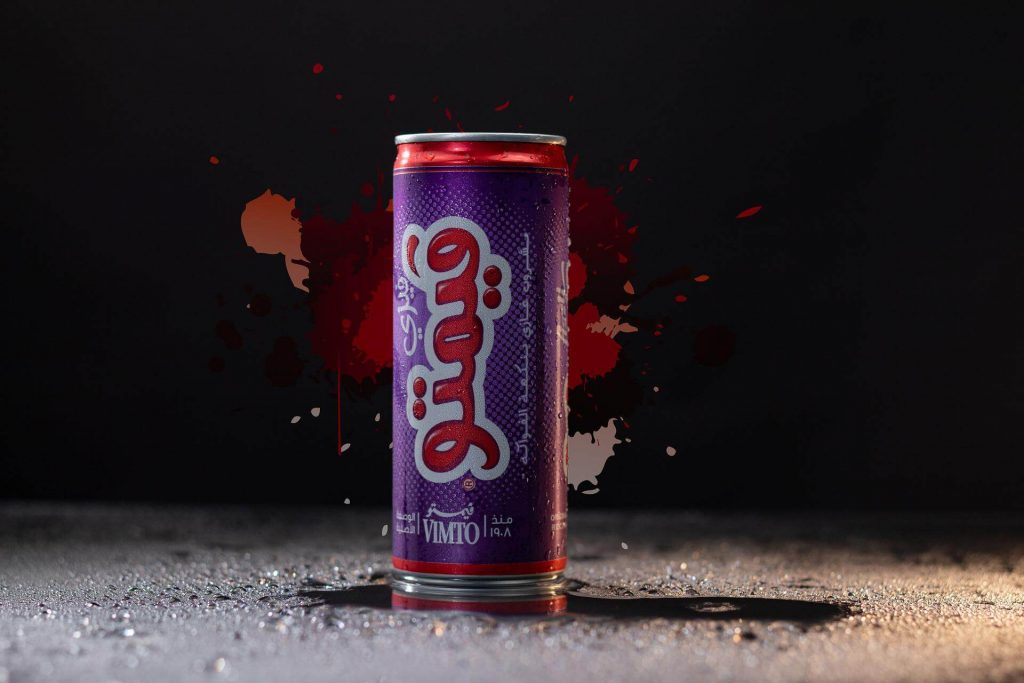
Vimto in the Middle East, and Around the World
Over the years the popularity of Vimto has gone from the Manchester streets to all around the world. An interesting tale relates to the Middle East and the Arabian Peninsula. During Ramadan, the drink becomes incredibly popular. This is probably due to the high sugar count helping people through their daily fasts. The Arabian Peninsula is the biggest foreign market and sales boom during the holy month, with the drink being the biggest selling beverage in certain countries.
Vimto’s popularity in this part of the world stretches back an impressive 80 years, and that popularity only seems to be growing.
Variations of the Drink
The good people at Vimto have never rested on their laurels, and throughout the drink’s history, many different varieties have been introduced. The standard Vimto is sold in both pre-mixed carbonated and cordial versions, with the latter being the more popular choice. In the winter months, the cordial version is often added to hot water to create a sweet, warming drink.
Through the decades Vimto has also released jelly babies, ice lollies, and other sweets featuring the distinctive brand flavour. And the drinks range often makes room for limited edition guest flavours, such as Cherry Vimto and Strawberry Vimto.
For those who haven’t been inspired by Vimto’s early temperance movement origins, you can use the drink as an inspiration and make a pretty moreish cocktail known as a Cheeky Vimto. Although the cocktail doesn’t feature actual Vimto as an ingredient, the blending of port wine and Blue WKD creates an alcoholic drink that captures something of Vimto’s unique berry blast.
Finally, if it’s sunny out, you may want to toss Vimto into a blender with ice cream and milk to create an indulgent Vimto milkshake.
The Vimto Statue
Anyone wanting to explore the culture surrounding Vimto in Manchester today should head to Granby Row in Manchester city centre where they’ll find a massive wooden sculpture of a Vimto bottle. This massive tribute to a Manchester classic is always a popular stop on our food tours of Manchester.
Would you like to learn more about Manchester and its incredible food scene? Are you looking for the best things to do in Manchester? If so, book a food tour with us and let us show you our city!
If you have any questions or comments regarding our tours, please get in touch.
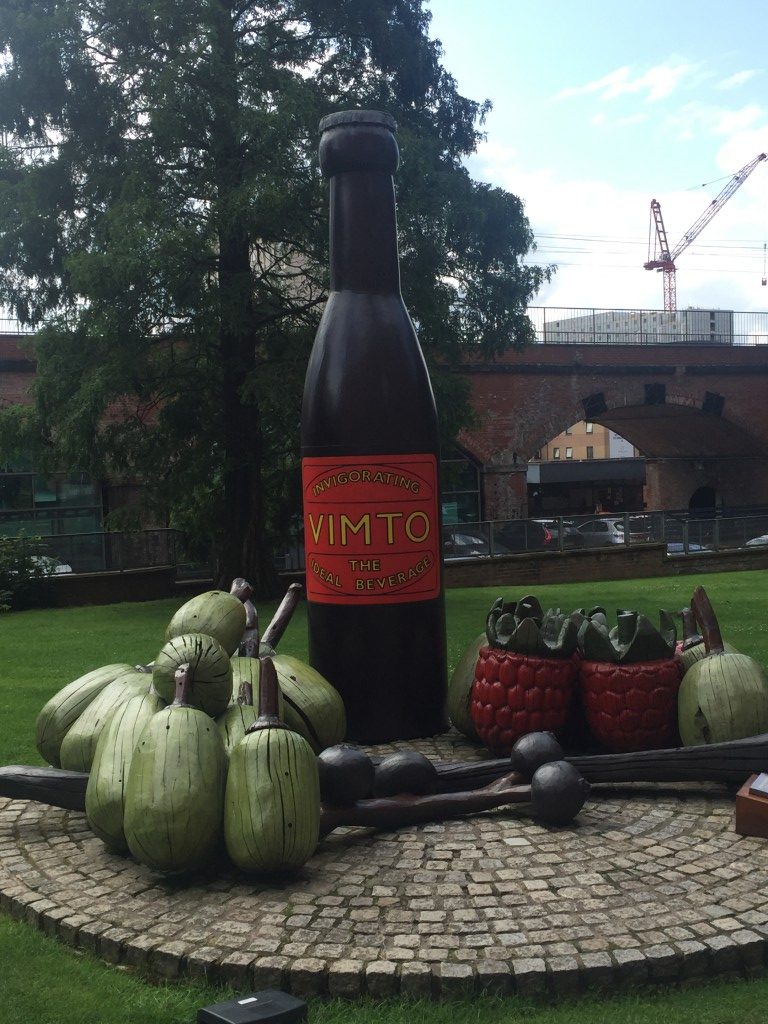
The Arndale Shopping Centre. Love it or hate it?
Manchester’s Arndale centre is a marmite building. You either love it or hate it. I think most of us hate it but have at least some fond memories of how it was when we were younger.
It was built in phases between 1972 and 1979. At the official opening the Mayor of manchester, Dame Kathleen Olerenshaw said disappointingly, “I didn’t think it would look like that.”
During the 80’s a retail company called Arndale owned quite a few shopping centres around the UK. This was the biggest. In 1996 the IRA bomb was detonated right under the bridge that connected the Arndale to Marks and Spencers. Following this the centre was refurbished to look more like it does today.
Interestingly enough, in the 1970’s there was a plan to build an underground railway station in the Arndale. The council had a plan to link Piccadilly and Victoria train stations via an underground line. Nothing ever came of this and today we have the metrolink.
It’s not all bad, the food market is even on our food tour.
Manchester has an out of town shopping centre called The Trafford Centre. The Arndale however is still the busiest of the two.
We visit the Arndale centre on our food tour. In fact the best part of the Arndale is on our food tour. The food market is at the High street entrance, next to Shudehill. This is still a hidden gem in the heart of the city. When we were doing our food tour research we asked a lot of people if they knew this market existed. Suprisingly, a lot of local mancunians had no idea of its existence. Another great reason to take a food tour.
If you’d like to learn more about Manchester and especially the food scene, book a food tour with us. www.manchesterbites.com
For more information about Manchester’s food scene follow our blog at www.manchesterbites.com/blog
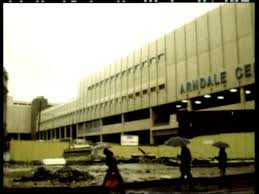
The story of Manchester’s Town Hall.
Arguably one of the most famous buildings in Manchester is our town hall. The town hall was opened in 1877 and cost about a million pounds which is a huge amount of money. The architecture is Victorian, Neo-gothic style. At the moment the building is closed for renovations that aren’t due to be finished until 2024.
The centre of Manchester’s Industrial Revolution
The town hall is one of fifteen grade 1 listed buildings in the city. If you look to the very top of the bell tower you will see a spiky golden globe. This represents 2 things. The first is a ripe cotton seed. Manchester is of course famous for it’s cotton industry. The second representation is that of the sun. The sun never set on Manchester’s cotton empire. You can imagine back in the industrial revolution days, this was one of the world’s great seats of power.
The town hall is in the centre of Manchester. At the front of the hall is Albert Square. This has been the location for many of Manchester’s great celebrations such as Christmas light switch ons and Manchester United’s many trophy parties. We have also seen sadness here. Manchester gathered in Albert square the day after the 2017 Arena bombing to pay tribute to those who died.
Behind the town hall is St Peter’s square and our famous Central library.
Many of you might recognize Manchester’s town hall from TV and films. Due to it’s unique architecture and it’s proximity to media city it is often used for filming. Films such as Sherlock Holmes and the Iron lady were filmed here. Amongst the many TV shows that have filmed here include A very English scandal.
If you would like to learn more about Manchester and the people that make it tick book a food tour with us. www.manchesterbites.com
